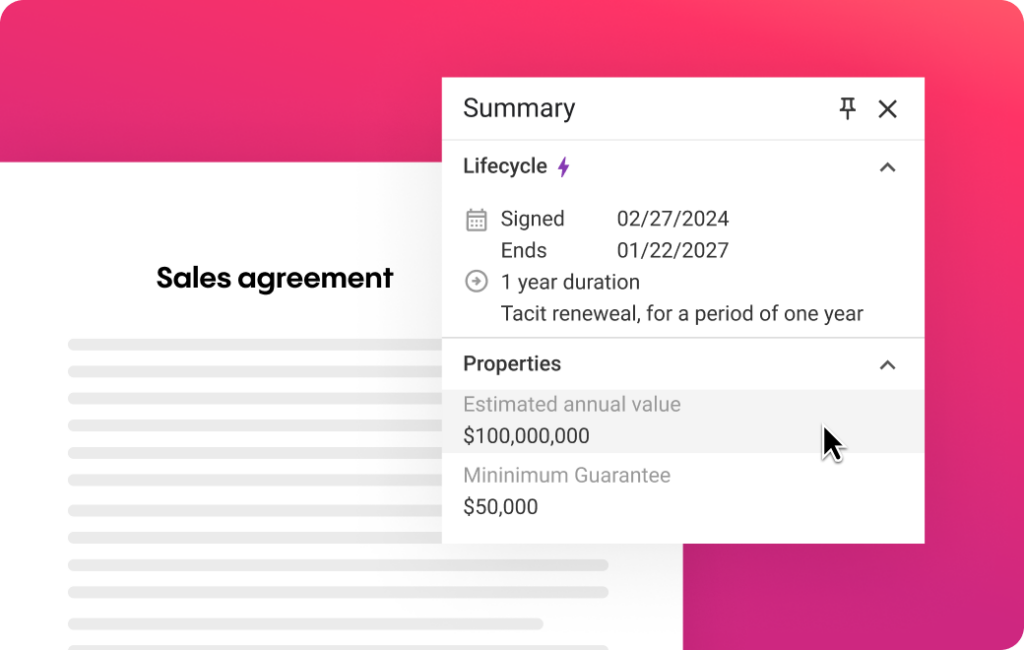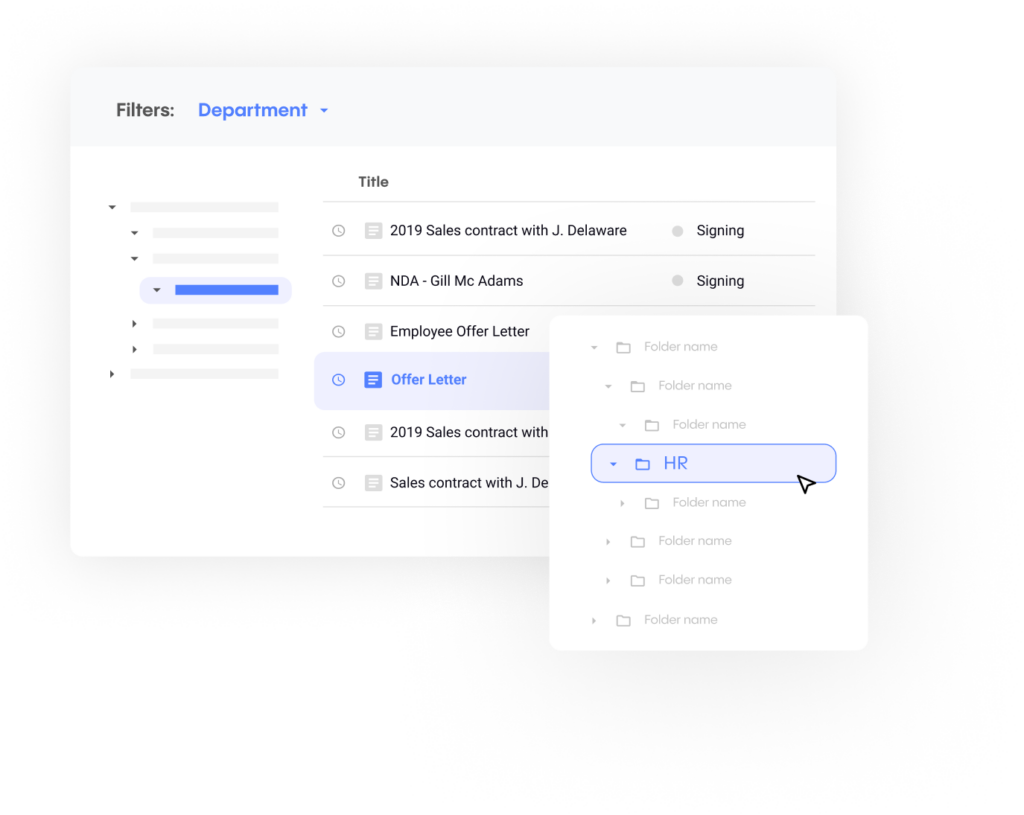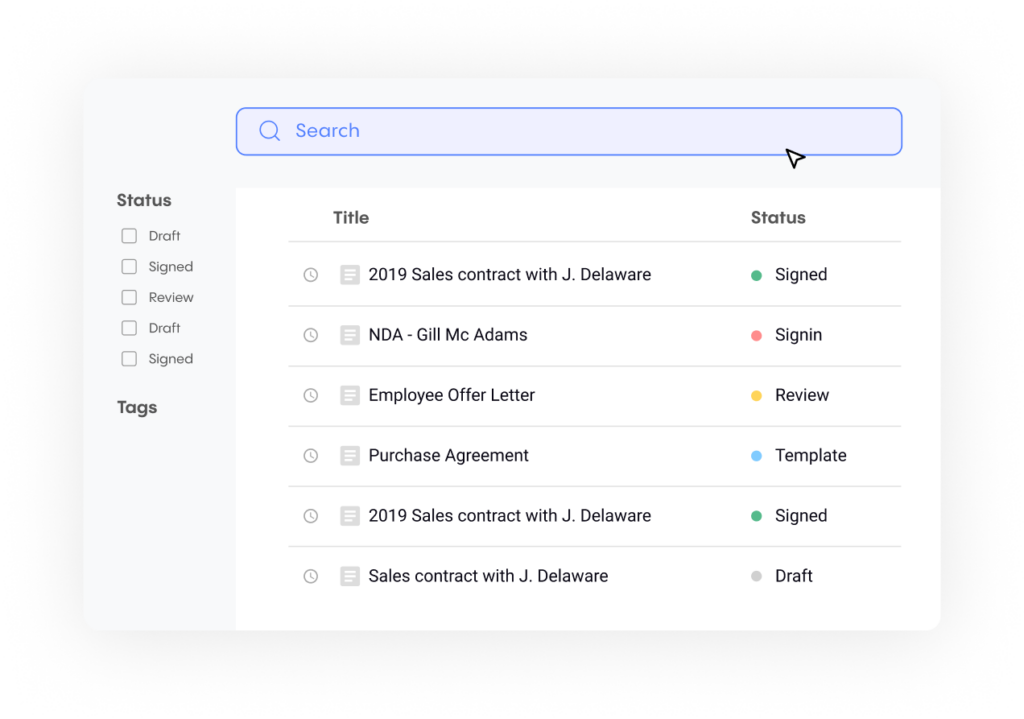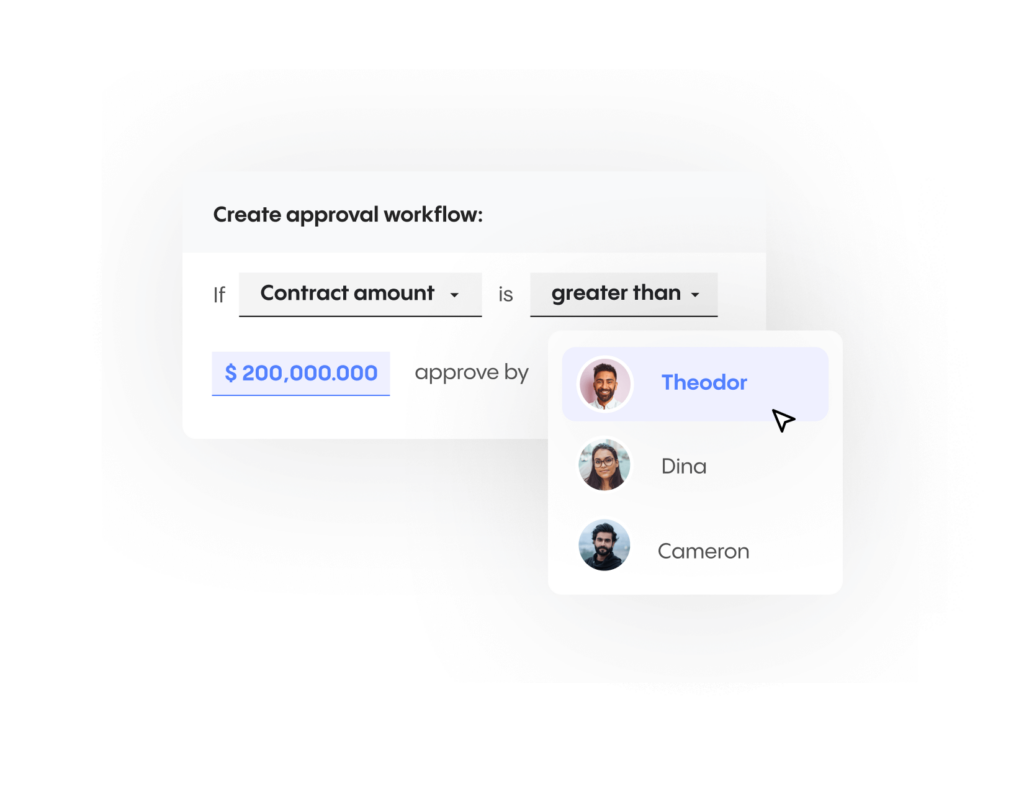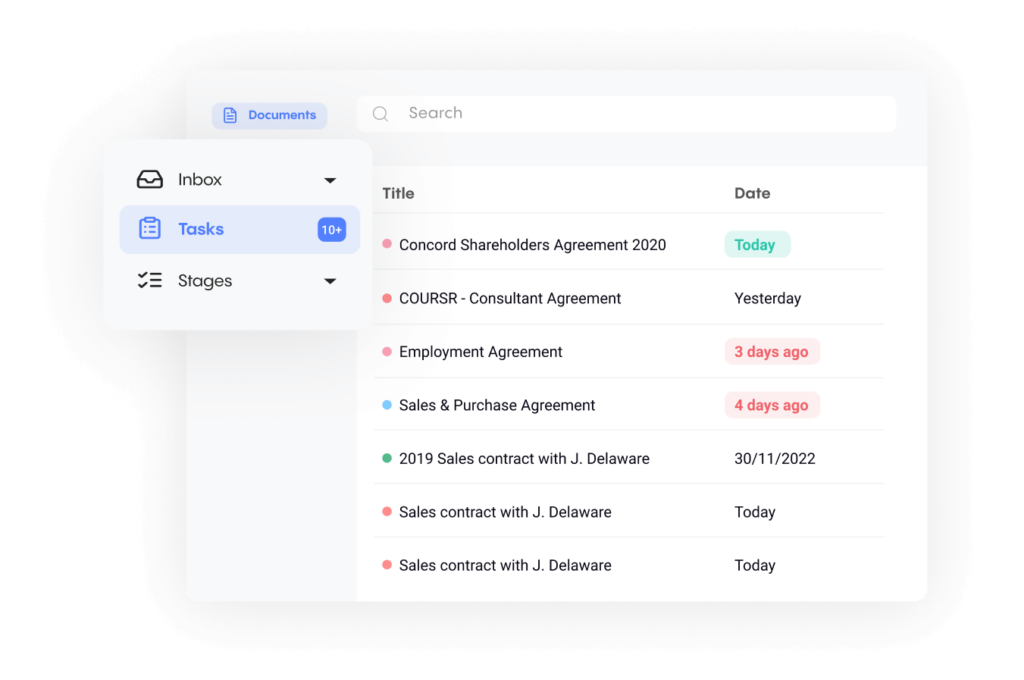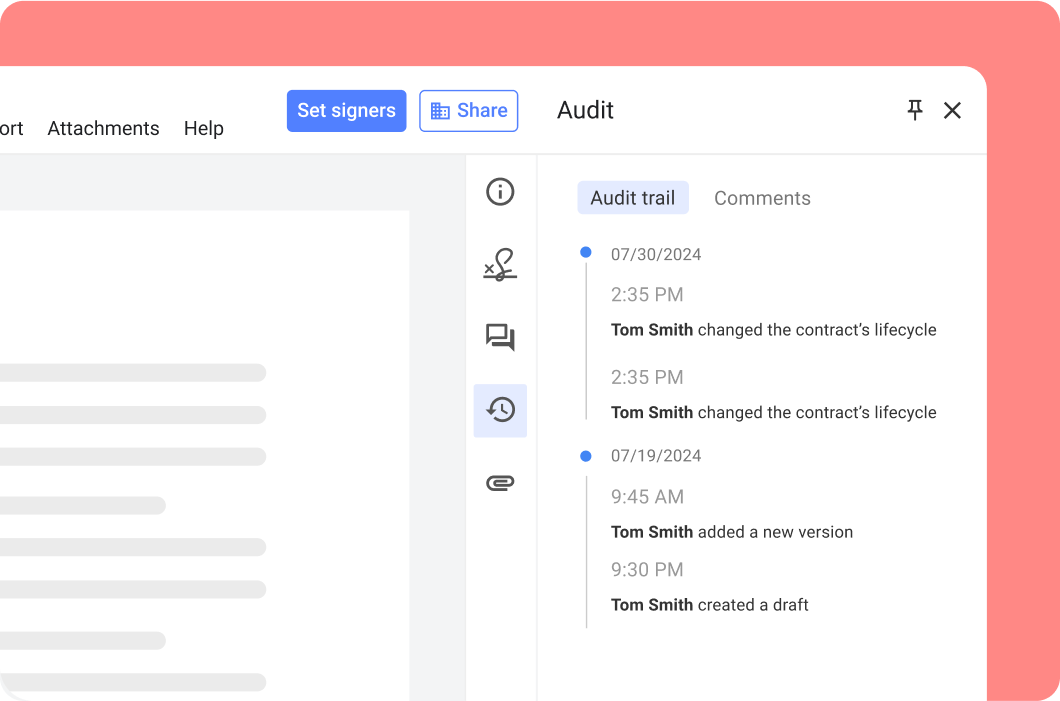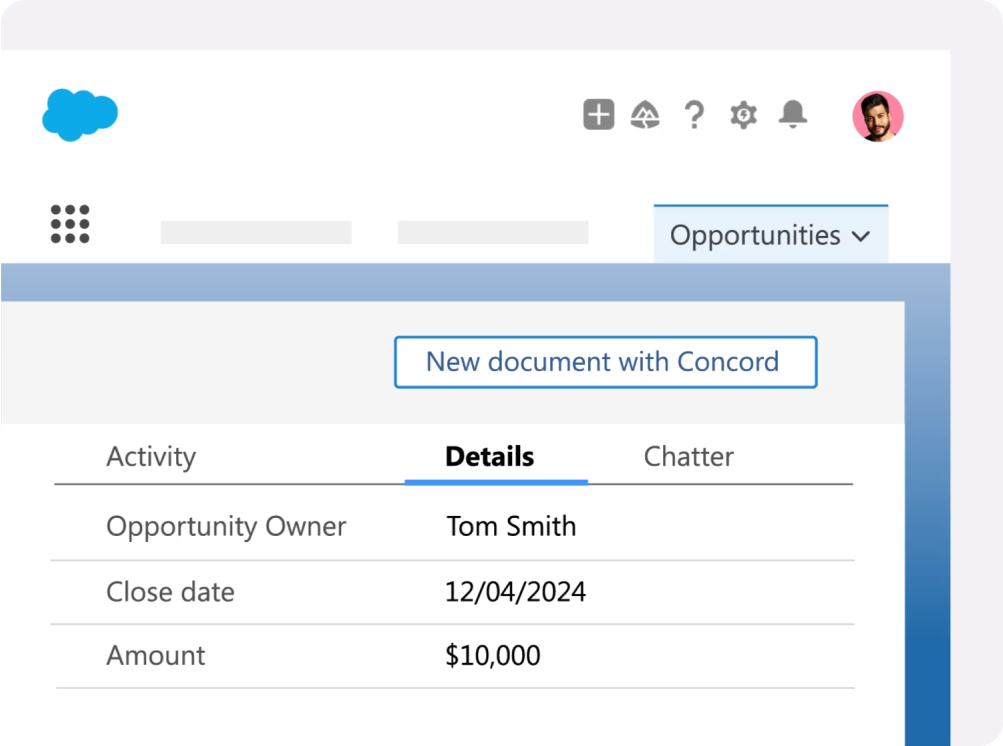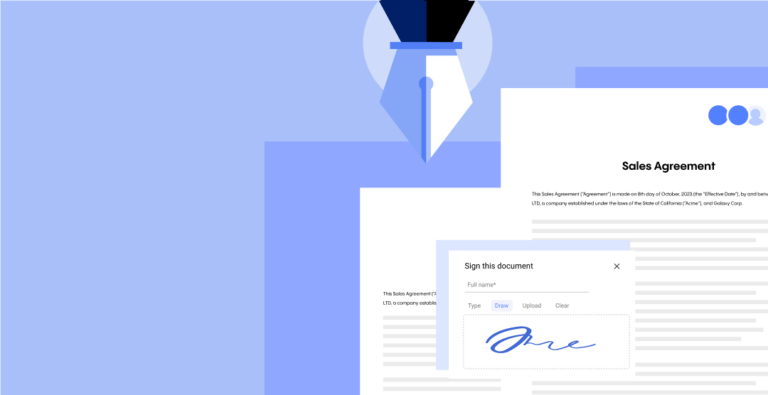Table of Contents
What is Contract Workflow?
Contract workflow is the structured sequence of activities, approvals, and handoffs that move agreements from initial request through negotiation, execution, and ongoing management. It encompasses both human decisions and automated processes designed to ensure contracts move efficiently while maintaining appropriate controls and compliance.
Modern contract workflows integrate three fundamental dimensions:
- Process Architecture: How contracts move through organizational touchpoints and approval hierarchies
- Information Flow: The movement and transformation of data throughout the contract lifecycle
- Stakeholder Orchestration: Coordination of legal, finance, procurement, sales, and external parties
Organizations with optimized workflows complete contract reviews in just 8 days compared to 47 days for those using manual processes – an 83% reduction in cycle time.
Contract Workflow Performance Metrics
- 8 days – Best-in-class contract review time
- 47 days – Average review time for manual processes
- 30% – Operational expense reduction with workflow automation
- 9% – Average contract value erosion from poor workflows
- 44% – Researcher time spent on administrative tasks
Understanding contract workflow: Beyond simple automation
Contract workflow encompasses the entire ecosystem of activities, decisions, and handoffs that move agreements from initial request through execution and ongoing management. This definition extends beyond basic task automation to include the complex interplay of human judgment, automated processes, and organizational dynamics.
The anatomy of modern contract workflows
Effective contract workflows integrate three fundamental dimensions:
Process Architecture: The structural design of how contracts move through organizational touchpoints, including approval hierarchies, parallel reviews, and conditional routing based on contract characteristics.
Information Flow: The movement and transformation of data throughout the contract lifecycle, from initial intake through final repository storage and subsequent retrieval for business intelligence.
Stakeholder Orchestration: The coordination of diverse participants—legal, finance, procurement, sales, and external parties—each with distinct requirements and timelines.
Gartner’s definition of contract lifecycle management emphasizes this holistic view, describing it as solutions that “proactively manage contracts from initiation through award, compliance and renewal stages.” This comprehensive approach distinguishes strategic workflow design from mere task automation.
Why traditional workflows fail at scale
Manual contract workflows create compound inefficiencies that multiply across organizations. The problem isn’t simply speed—it’s the cascading impact of process friction on business agility. When contracts languish in email chains or spreadsheet trackers, organizations experience:
- Decision Paralysis: Unclear ownership and approval authorities delay critical business decisions
- Information Asymmetry: Stakeholders operate with different versions of truth, creating conflicting priorities
- Risk Accumulation: Compliance gaps and missed obligations compound silently until crisis emerges
As Deloitte’s global operations demonstrate with $67.2 billion in 2024 revenue, scale demands sophisticated workflow orchestration. Their consolidation from five to four business units reflects how operational complexity requires constant workflow refinement.
The business impact of optimized contract workflows
Quantifying workflow efficiency gains
The financial impact of workflow optimization extends far beyond time savings. According to Gartner research cited by Quixy, integrating hyper-automation technology with improved operational procedures reduces operational expenses by 30%. For organizations managing thousands of contracts annually, this represents millions in recovered value.
Consider the cascade effect of workflow improvements:
| Workflow Metric | Traditional Process | Optimized Workflow | Business Impact |
|---|---|---|---|
| Contract cycle time | 42-47 days | 8-10 days | 80% faster deal closure |
| Approval bottlenecks | 2 hours per handoff | 5 minutes automated | 96% efficiency gain |
| Version control errors | 10% of contracts | <1% with automation | 90% risk reduction |
| Stakeholder visibility | Request-based | Real-time dashboards | Proactive management |
The hidden costs of workflow friction
Beyond measurable delays, poor workflows create shadow costs that erode organizational effectiveness:
Opportunity Cost: WorldCC’s 2023 benchmark report reveals average contract value erosion has reached nearly 9%. This erosion stems directly from inability to execute on negotiated terms due to workflow breakdowns.
Talent Drain: Federal Demonstration Partnership research shows 44% of researchers’ time is spent on administrative tasks. When highly skilled professionals become process administrators, innovation suffers.
Compliance Exposure: Fragmented workflows create audit nightmares. The U.S. government’s Contracting Professionals Smart Guide emphasizes how proper workflow documentation prevents compliance failures that can result in contract termination or legal penalties.
Core components of high-performing contract workflows
1. Intelligent intake and routing
Modern contract workflows begin before the contract exists. Intelligent intake systems capture request context, assess complexity, and route to appropriate workflows automatically. This front-end intelligence prevents the all-too-common scenario where simple amendments follow the same laborious path as complex negotiations.
World Commerce & Contracting research emphasizes that successful organizations design multiple workflow paths based on:
- Contract value thresholds
- Risk assessment scores
- Counterparty relationship status
- Regulatory requirements
- Business urgency indicators
Implementing structured contract workflow automation starts with mapping these decision criteria to create dynamic routing rules that adapt to business context.
2. Parallel processing architecture
Sequential approval chains represent industrial-age thinking in a digital world. High-performing workflows leverage parallel processing wherever possible, allowing multiple reviewers to assess contracts simultaneously while maintaining clear accountability.
The University of Oxford’s research contract guidelines demonstrate this principle: legal review proceeds in parallel with technical assessment, dramatically reducing overall cycle time while maintaining rigorous standards.
Key design principles for parallel workflows:
- Conditional Dependencies: Some reviews must complete before others begin (e.g., initial risk assessment before detailed legal review)
- Escalation Triggers: Automatic elevation when parallel reviewers disagree or identify high-risk elements
- Consolidation Points: Clear merger of parallel feedback into unified negotiation positions
3. Automated compliance checkpoints
Embedding compliance directly into workflows prevents costly retroactive fixes. Government contract management practices emphasize that compliance isn’t a separate activity—it’s woven throughout the workflow fabric.
Modern contract compliance audit capabilities integrate real-time checks for:
- Regulatory alignment (GDPR, HIPAA, SOX)
- Internal policy adherence
- Budget authorization limits
- Vendor qualification status
- Insurance and bonding requirements
4. Dynamic approval hierarchies
Static approval chains ignore business reality. A $10,000 services contract shouldn’t follow the same path as a $10 million strategic partnership. Dynamic workflows adjust approval requirements based on multiple factors:
Aberdeen Group research cited by IndustryWeek notes that best-in-class organizations are 43% more likely to maintain central contract repositories with role-based access—enabling flexible yet controlled approval processes.
5. Integration ecosystems
Isolated contract workflows create information silos. According to WorldCC’s research, contract data is scattered across 24 different systems in medium to large businesses. This fragmentation multiplies workflow complexity exponentially.
Effective contract management reporting requires workflows that seamlessly connect with:
- ERP systems for financial data
- CRM platforms for relationship context
- Procurement systems for vendor management
- Document management for version control
- Business intelligence for analytics
Designing workflows for different contract types
Sales contract workflows: Speed meets governance
Sales contracts demand velocity without sacrificing accuracy. Sales contract automation must balance the urgency of closing deals with the necessity of protecting organizational interests.
Research from Forrester and Aberdeen Group shows it takes an average of 3.4 weeks to get a contract approved—death for sales momentum. Optimized sales workflows address this through:
Pre-approved frameworks: Parameterized templates where sales can adjust commercial terms within defined boundaries without legal review
Graduated escalation: Simple modifications flow through instantly; complex changes trigger targeted expert review
Customer-visible tracking: Contract tracking systems that provide transparency to both internal teams and customers, reducing follow-up friction
Procurement workflows: Risk mitigation focus
Procurement contracts carry different workflow requirements, emphasizing vendor qualification, competitive analysis, and long-term relationship management. Modern procurement process optimization shows that strategic sourcing requires workflows supporting:
- Multi-stage vendor evaluation
- Collaborative scoring mechanisms
- Competitive bid analysis
- Performance milestone tracking
- Automated renewal reminders well before expiration
Complex agreement workflows: Orchestrating complexity
Multi-party agreements, joint ventures, and strategic partnerships demand sophisticated workflow orchestration. These agreements often involve:
Phased negotiations: Initial framework agreements followed by detailed schedules
Multiple workstreams: Legal, technical, financial, and operational teams working in coordinated parallel
External collaboration: Secure portals for counterparty review and feedback
Version reconciliation: OCR-powered contract management to compare and merge multiple document versions
Technology enablers for modern workflows
The role of AI in workflow optimization
PwC’s 2025 AI predictions emphasize that organizations will deploy AI agents as digital workers, fundamentally transforming workflows. In contract management, AI enables:
Intelligent routing: ML algorithms learn from historical patterns to predict optimal approval paths
Risk scoring: NLP analyzes contract language to identify unusual terms requiring expert review
Auto-extraction: Key terms and obligations automatically populate contract management dashboards
Deloitte’s contract review platform, operational since 2014, demonstrates mature AI application—automatically extracting relevant information and reducing manual review time by orders of magnitude.
Low-code workflow builders
The gap between business needs and IT capabilities has historically limited workflow innovation. Low-code platforms democratize workflow design, enabling subject matter experts to create sophisticated automations without programming expertise.
Digital process automation market statistics show the market was valued at $7.8 billion in 2019 and is projected to reach $16 billion by 2025—reflecting explosive demand for accessible automation tools.
API-first architecture
Modern workflows demand seamless data flow between systems. API-first design ensures that legal operations software can connect with any business system, preventing the data silos that cripple traditional workflows.
Stanford University’s research administration demonstrates this principle—different agreement types flow through unified systems while maintaining distinct processing rules.
Implementation roadmap: From current state to excellence
Phase 1: Workflow assessment and documentation (Weeks 1-3)
Before designing future workflows, understand current reality. This phase uncovers the hidden complexity in existing processes:
Process mapping exercises: Trace actual contract paths, not theoretical ones. Shadow contracts through the organization to identify:
- Unofficial workarounds that bypass formal processes
- Hidden approval steps that add no value
- Information bottlenecks where contracts stall
Stakeholder interviews: Understand pain points from every perspective:
- Legal teams frustrated by last-minute fire drills
- Sales teams losing deals to slow approvals
- Finance teams lacking visibility into commitments
- Procurement teams managing vendors through spreadsheets
Data analysis: Quantify current performance:
- Average cycle times by contract type
- Bottleneck identification through timestamp analysis
- Error rates and rework frequency
- Compliance incident tracking
Phase 2: Workflow design and optimization (Weeks 4-6)
Armed with current state understanding, design workflows that address root causes, not symptoms:
Design principles:
- Eliminate non-value-adding steps
- Automate information transfer
- Parallelize independent reviews
- Build in compliance by design
- Enable exception handling without breaking flow
Agreement approval workflow design should reflect organizational reality while pushing toward best practices. Start with quick wins—simple contracts that can demonstrate dramatic improvements.
Phase 3: Technology selection and configuration (Weeks 7-10)
Avoid the trap of selecting technology before defining workflows. With clear workflow designs, evaluate platforms based on:
Flexibility: Can the system adapt to your workflows, or must you conform to its limitations?
Integration: Does it connect with your existing technology stack?
Scalability: Will it grow with your organization?
Usability: Can business users manage workflows without IT dependency?
Gartner recognizes leaders in workflow automation based on these criteria. However, beware of overly complex platforms—as seen with competitors like Ironclad, where 6+ month implementations are common and costs can spiral into six figures annually.
Phase 4: Pilot and iteration (Weeks 11-14)
Start small with a controlled pilot:
Select pilot scope: Choose one department or contract type for initial implementation
Define success metrics: Clear, measurable objectives (e.g., reduce cycle time by 50%)
Gather feedback actively: Daily standups during pilot to address issues immediately
Iterate rapidly: Adjust workflows based on real-world usage
SaaS contract management often provides an ideal pilot use case—high volume, relatively standardized, and measurable impact.
Phase 5: Rollout and optimization (Ongoing)
Successful pilots build momentum for broader adoption:
Phased expansion: Add contract types and departments systematically
Change management: Invest in training and communication
Continuous improvement: Regular workflow reviews and optimizations
Performance monitoring: Maintain security and compliance while driving efficiency
Advanced workflow strategies
Conditional logic and smart routing
Simple workflows follow linear paths. Sophisticated workflows adapt to context through conditional logic:
Risk-based routing: High-risk contracts automatically route to senior counsel
Value thresholds: Approval levels adjust based on contract value
Relationship routing: Existing vendor amendments follow streamlined paths
Regulatory requirements: Healthcare contracts trigger HIPAA compliance workflows
Workflow analytics and optimization
Deloitte’s 2024 Workflow Automation Outlook with ServiceNow emphasizes that 79% of CEOs look to automation for increased efficiency. But efficiency requires measurement:
Key workflow metrics:
- Cycle time by stage and contract type
- Bottleneck analysis with heat mapping
- Error rates and rework frequency
- User adoption and satisfaction scores
- Compliance adherence rates
Cross-functional workflow orchestration
Modern businesses operate through collaborative networks, not hierarchical chains. Efficient CLM for vendor agreements requires workflows that span organizational boundaries:
Internal collaboration: Legal, procurement, finance, and operations working in concert
External collaboration: Secure vendor portals for negotiation and review
Multi-party coordination: Complex agreements with multiple stakeholders
UK government contract management standards provide frameworks for managing these complex stakeholder relationships while maintaining control and compliance.
Measuring workflow success
Operational metrics that matter
Track metrics that drive business value, not vanity statistics:
| Metric Category | Key Indicators | Target State | Business Impact |
|---|---|---|---|
| Speed | Contract cycle time | 80% reduction | Faster revenue recognition |
| Quality | Error rates | <1% requiring rework | Reduced legal risk |
| Compliance | Audit findings | Zero critical findings | Regulatory confidence |
| Adoption | Active user percentage | >90% of stakeholders | Process adherence |
| Value | Cost per contract | 50% reduction | Direct ROI |
Financial impact measurement
Workflow improvements deliver measurable financial returns:
Direct cost savings: Reduced administrative hours multiplied by loaded labor costs
Opportunity capture: Faster contract execution enables more deals
Risk mitigation: Avoided penalties and litigation through better compliance
Strategic value: Improved vendor relationships and negotiation outcomes
The Australian Government Contract Management Guide emphasizes value measurement throughout the contract lifecycle—a principle that applies equally to private sector workflows.
Common workflow pitfalls and solutions
Pitfall 1: Over-engineering workflows
Problem: Creating workflows so complex that users circumvent them
Solution: Start simple, add complexity only when justified by value
Example: Initial workflows might have 3-5 steps; add conditional branches only after baseline adoption
Pitfall 2: Ignoring change management
Problem: Perfect workflows fail without user adoption
Solution: Invest heavily in training, communication, and stakeholder buy-in
Key insight: According to research, 30% of organizations have strategically linked ESG initiatives with contracts—showing that workflow adoption requires aligning with broader organizational values
Pitfall 3: Static workflow design
Problem: Workflows that can’t adapt to business change
Solution: Build flexibility into workflow architecture
Implementation: Regular review cycles, user feedback loops, and platform flexibility
Pitfall 4: Integration afterthoughts
Problem: Workflows that create new data silos
Solution: Design with integration from day one
Technical requirement: APIs, webhooks, and real-time data synchronization
Future-proofing your contract workflows
Emerging technologies and their impact
The contract workflow landscape continues evolving rapidly:
Blockchain integration: Immutable audit trails and smart contract execution
Advanced AI: Predictive analytics for optimal workflow paths
Process mining: Continuous workflow optimization through pattern analysis
Robotic process automation: Handling routine tasks without human intervention
Workflow automation market growth of 20% annually, reaching $5 billion by 2024, signals continued innovation and investment.
Building adaptive workflows
Future-ready workflows share common characteristics:
- Modularity: Components can be reconfigured without wholesale replacement
- Scalability: Workflows handle 10x volume without breaking
- Intelligence: Self-optimizing based on performance data
- Resilience: Graceful degradation when systems fail
- Compliance-ready: Adapting to regulatory changes automatically
Industry-specific workflow considerations
Healthcare contract workflows
Healthcare organizations face unique workflow challenges:
- HIPAA compliance requirements
- Complex payer relationships
- Physician credentialing integration
- Critical contract reminder software for credentialing deadlines
Academic research on nonprofit contract workflows shows that standardization dramatically improves efficiency while maintaining compliance.
Financial services workflows
Regulatory density in financial services demands sophisticated workflows:
- Multi-jurisdiction compliance checking
- Automated risk scoring
- Audit trail completeness
- Real-time regulatory updates
Technology sector workflows
Fast-moving technology companies require agile workflows:
- Rapid iteration capabilities
- API-first integration
- Global collaboration support
- Intellectual property protection
Taking action: Your workflow transformation journey
Transform contract chaos into operational excellence by taking these concrete steps:
- Audit current workflows – Document actual processes, not theoretical ones
- Identify quick wins – Find high-volume, low-complexity contracts for initial automation
- Build stakeholder coalition – Ensure buy-in from legal, sales, procurement, and finance
- Design future state – Create workflows that balance speed with control
- Select appropriate technology – Choose platforms that fit your complexity and scale
- Pilot systematically – Test with real contracts and real users
- Measure relentlessly – Track metrics that matter to the business
- Iterate continuously – Workflow excellence is a journey, not a destination
The difference between organizations struggling with contract bottlenecks and those achieving operational excellence often comes down to workflow design. As the data demonstrates, the investment in workflow optimization pays dividends through faster cycle times, reduced risk, and improved stakeholder satisfaction.
Frequently Asked Questions About Contract Workflow
What exactly is contract workflow?
Contract workflow is the structured sequence of activities, approvals, and handoffs that move agreements from initial request through negotiation, execution, and ongoing management. It encompasses both human decisions and automated processes, designed to ensure contracts move efficiently while maintaining appropriate controls and compliance. Modern contract workflow goes beyond simple approval chains to include intelligent routing, parallel processing, and integration with business systems.
How long does it take to implement new contract workflows?
Implementation timelines vary based on complexity and organizational readiness. A focused pilot for one contract type can be operational in 4-6 weeks. Enterprise-wide workflow transformation typically requires 3-6 months for full deployment. However, modern low-code platforms enable much faster implementation than traditional systems—some organizations see initial workflows running in days, not months. The key is starting with simple workflows and expanding systematically.
What’s the ROI of contract workflow automation?
Organizations typically see 50-80% reduction in contract cycle time, translating to faster revenue recognition and reduced administrative costs. Aberdeen Group research shows best-in-class companies achieve contract approval in 8 days versus 47 for laggards. Direct cost savings often reach 30% through reduced manual processing. Additional value comes from risk reduction, improved compliance, and better stakeholder relationships—benefits that multiply over time.
What are the most common workflow bottlenecks?
The most frequent bottlenecks include unclear approval authority (who can approve what), sequential review processes that should run in parallel, lack of visibility into contract status, and poor integration between systems causing manual data re-entry. Missing information that triggers back-and-forth also significantly delays workflows. These bottlenecks compound when organizations lack standardized templates and clear escalation procedures.
How do we maintain security in automated workflows?
Security in automated workflows requires multiple layers: role-based access controls ensuring only authorized users see sensitive contracts, encryption for data in transit and at rest, comprehensive audit trails tracking every action, and regular security assessments. Integration security is crucial—ensuring data flows between systems maintain protection. Leading platforms maintain SOC 2 compliance and industry-specific certifications.
Can small businesses benefit from contract workflow automation?
Absolutely. Small businesses often see proportionally greater benefits because they lack the administrative infrastructure of larger organizations. With modern SaaS solutions starting around $399 monthly, the ROI is immediate through time savings alone. Small businesses can implement sophisticated workflows without IT departments, using intuitive drag-and-drop builders. The key is choosing right-sized solutions rather than overly complex enterprise platforms.
How to Implement Contract Workflow Automation with Concord
Transform your contract processes from manual bottlenecks to streamlined workflows using Concord’s intuitive platform. This guide shows you how to achieve 80% faster contract cycles.
Assess Your Current Contract Process
Document your existing contract workflows to identify bottlenecks:
- Map current approval chains and handoffs
- Identify where contracts typically stall
- Calculate average cycle times by contract type
- Survey stakeholders about pain points
Most organizations discover 60-70% of steps add no value and can be eliminated or automated.
Design Your Optimized Workflow in Concord
Use Concord’s visual workflow builder to create efficient processes:
- Parallel approvals: Run legal and finance reviews simultaneously
- Conditional routing: Different paths based on contract value or type
- Automated notifications: Keep all stakeholders informed automatically
- Smart escalations: Auto-escalate stalled contracts to managers
Concord’s drag-and-drop interface lets business users design workflows without IT involvement.
Configure Integrations and Templates
Connect Concord to your existing systems for seamless data flow:
- CRM Integration: Pull customer data directly into contracts
- E-signature: Built-in signing eliminates separate tools
- Document storage: Sync with Google Drive, Dropbox, or Box
- Zapier connection: Link to 5,000+ other applications
Create templates with pre-approved language and variable fields to accelerate contract creation.
Launch Your Pilot Program
Start with a focused pilot to prove value quickly:
- Select one high-volume contract type (e.g., NDAs or sales agreements)
- Train a small group of power users
- Run the pilot for 2-4 weeks
- Track metrics: cycle time, user satisfaction, error rates
- Gather feedback and refine the workflow
Concord customers typically see 50% cycle time reduction within the first month.
Scale and Optimize
Expand successful workflows across your organization:
- Roll out to additional contract types and departments
- Use Concord’s analytics to identify optimization opportunities
- Implement AI-powered features for intelligent routing
- Create department-specific workflows while maintaining central control
- Continuously monitor performance metrics
With Concord’s Agreement Intelligence, workflows become smarter over time, learning from patterns to suggest optimal paths.
Expected outcomes: 80% faster contract cycles, 30% reduction in administrative costs, improved compliance, and complete visibility into contract status. Join thousands of organizations that have transformed their contract workflows with Concord.
Bibliography
- World Commerce & Contracting. (2024). “World Commerce & Contracting Report Reveals Critical Decline in Business Contract Effectiveness”
- Aberdeen Group. (2022). “Aberdeen Group Report – Procurement Contract Lifecycle Management Solutions”
- Gartner. (2024). “Best Contract Life Cycle Management Reviews 2024”
- Quixy. (2024). “65+ Workflow Automation Statistics and Forecast in 2024”
- World Commerce & Contracting. (2023). “WorldCC releases free 2023 benchmark report”
- Federal Demonstration Partnership. (2023). “Streamlining the Higher Education Research Lifecycle”
- U.S. Government. (2024). “Contracting Professionals Smart Guide”
- PwC. (2025). “2025 AI Business Predictions”
- Deloitte. (2024). “Deloitte Releases 2024 Workflow Automation Outlook Report With ServiceNow”
- IndustryWeek. (2024). “5 Best Practices Toward Contract Compliance”
- OpenGov. (2024). “Contract Management – The Complete Guide”
- UK Government. (2019). “Contract management professional standards”
- Cflow. (2025). “Workflow Automation Statistics & Trends in 2025”
- Australian Government. (2023). “Australian Government Contract Management Guide”
- Workona. (2024). “40+ Workflow Automation Trends & Statistics”



